Cross-Cultural Management Report: Australia and England Analysis
VerifiedAdded on 2020/04/07
|12
|2421
|366
Report
AI Summary
This report delves into the realm of cross-cultural management, specifically examining the communication dynamics between Australia and England. It begins with an executive summary outlining the report's objectives, which include analyzing cultural differences and communication challenges in a business context. The report then provides a detailed comparison of Australian and English cultures, highlighting differences in communication styles, business etiquette, and cultural diversity. Key challenges in cross-cultural communication are identified, such as differing word meanings, speaking styles, non-verbal cues, and the impact of high and low-context cultures, as well as power distance. The report emphasizes the importance of understanding cross-cultural communication concepts, including cultural diversity, creating cultural awareness, and fostering mutual acceptance. A case study is presented, offering practical advice for an Australian businessperson seeking to communicate effectively in England. The report concludes with recommendations for overcoming communication barriers and emphasizes the significance of cultural sensitivity in global business interactions. Finally, it provides a comprehensive list of references to support the analysis.
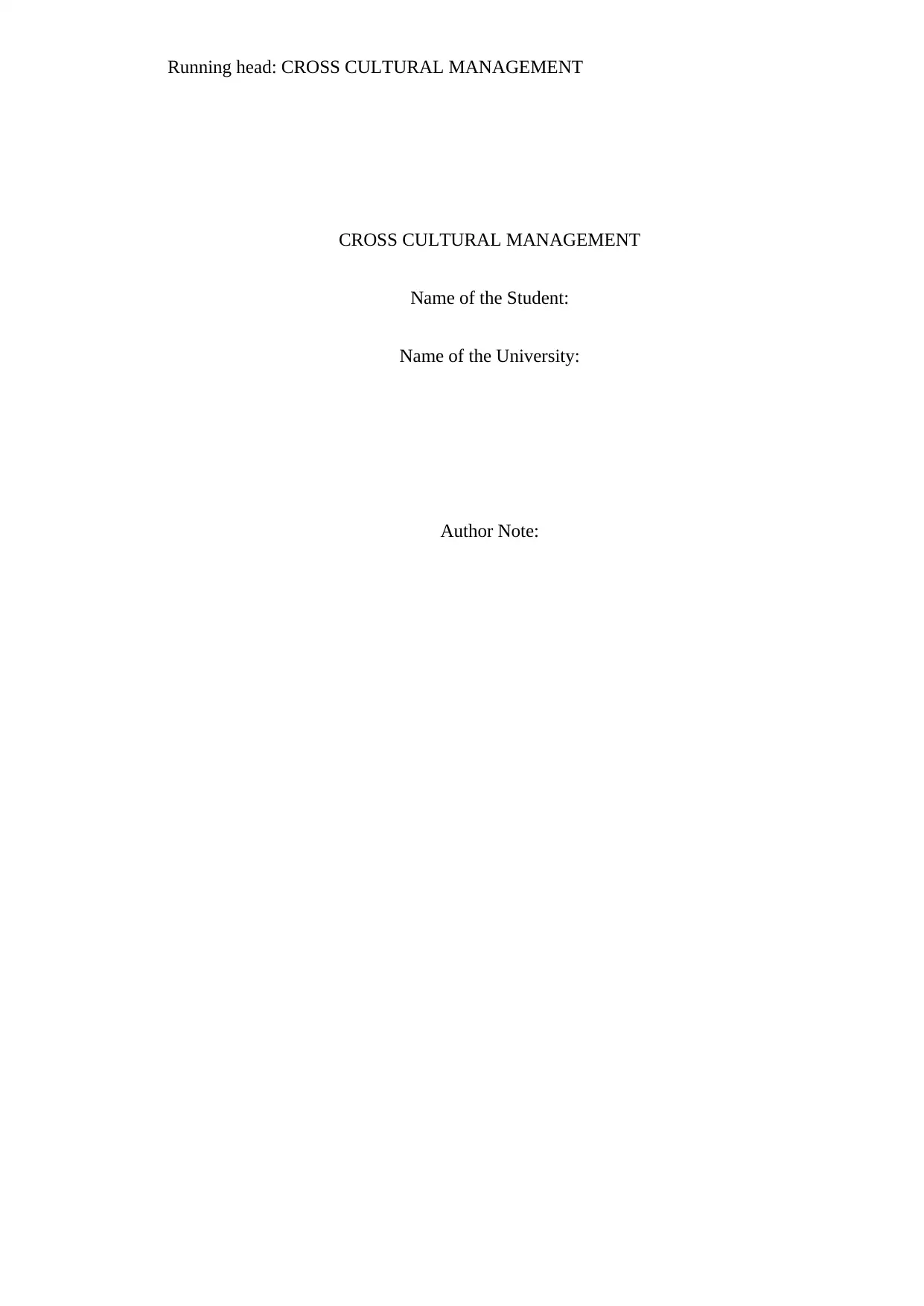
Running head: CROSS CULTURAL MANAGEMENT
CROSS CULTURAL MANAGEMENT
Name of the Student:
Name of the University:
Author Note:
CROSS CULTURAL MANAGEMENT
Name of the Student:
Name of the University:
Author Note:
Paraphrase This Document
Need a fresh take? Get an instant paraphrase of this document with our AI Paraphraser
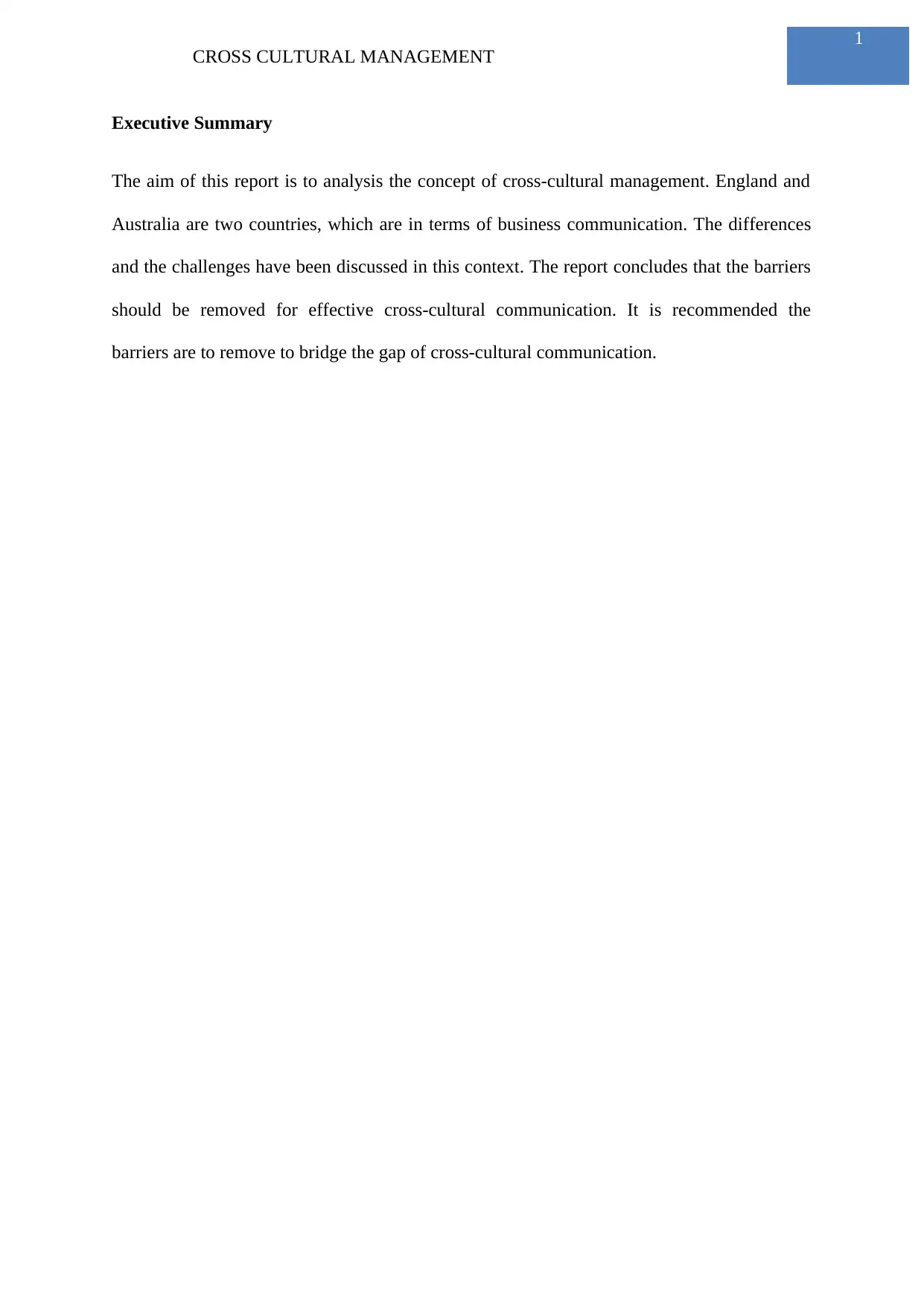
1
CROSS CULTURAL MANAGEMENT
Executive Summary
The aim of this report is to analysis the concept of cross-cultural management. England and
Australia are two countries, which are in terms of business communication. The differences
and the challenges have been discussed in this context. The report concludes that the barriers
should be removed for effective cross-cultural communication. It is recommended the
barriers are to remove to bridge the gap of cross-cultural communication.
CROSS CULTURAL MANAGEMENT
Executive Summary
The aim of this report is to analysis the concept of cross-cultural management. England and
Australia are two countries, which are in terms of business communication. The differences
and the challenges have been discussed in this context. The report concludes that the barriers
should be removed for effective cross-cultural communication. It is recommended the
barriers are to remove to bridge the gap of cross-cultural communication.
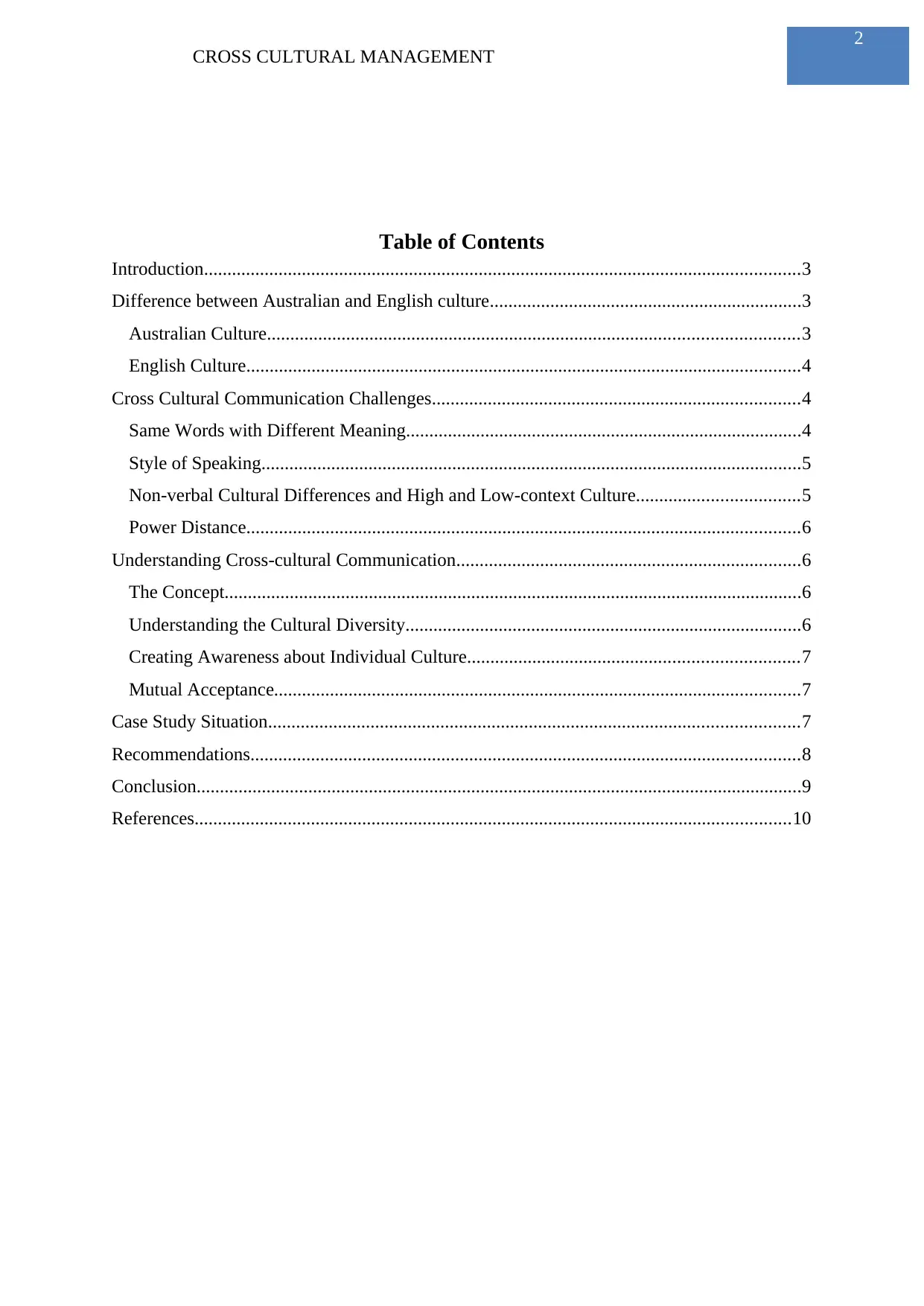
2
CROSS CULTURAL MANAGEMENT
Table of Contents
Introduction................................................................................................................................3
Difference between Australian and English culture...................................................................3
Australian Culture..................................................................................................................3
English Culture.......................................................................................................................4
Cross Cultural Communication Challenges...............................................................................4
Same Words with Different Meaning.....................................................................................4
Style of Speaking....................................................................................................................5
Non-verbal Cultural Differences and High and Low-context Culture...................................5
Power Distance.......................................................................................................................6
Understanding Cross-cultural Communication..........................................................................6
The Concept............................................................................................................................6
Understanding the Cultural Diversity.....................................................................................6
Creating Awareness about Individual Culture.......................................................................7
Mutual Acceptance.................................................................................................................7
Case Study Situation..................................................................................................................7
Recommendations......................................................................................................................8
Conclusion..................................................................................................................................9
References................................................................................................................................10
CROSS CULTURAL MANAGEMENT
Table of Contents
Introduction................................................................................................................................3
Difference between Australian and English culture...................................................................3
Australian Culture..................................................................................................................3
English Culture.......................................................................................................................4
Cross Cultural Communication Challenges...............................................................................4
Same Words with Different Meaning.....................................................................................4
Style of Speaking....................................................................................................................5
Non-verbal Cultural Differences and High and Low-context Culture...................................5
Power Distance.......................................................................................................................6
Understanding Cross-cultural Communication..........................................................................6
The Concept............................................................................................................................6
Understanding the Cultural Diversity.....................................................................................6
Creating Awareness about Individual Culture.......................................................................7
Mutual Acceptance.................................................................................................................7
Case Study Situation..................................................................................................................7
Recommendations......................................................................................................................8
Conclusion..................................................................................................................................9
References................................................................................................................................10
⊘ This is a preview!⊘
Do you want full access?
Subscribe today to unlock all pages.

Trusted by 1+ million students worldwide
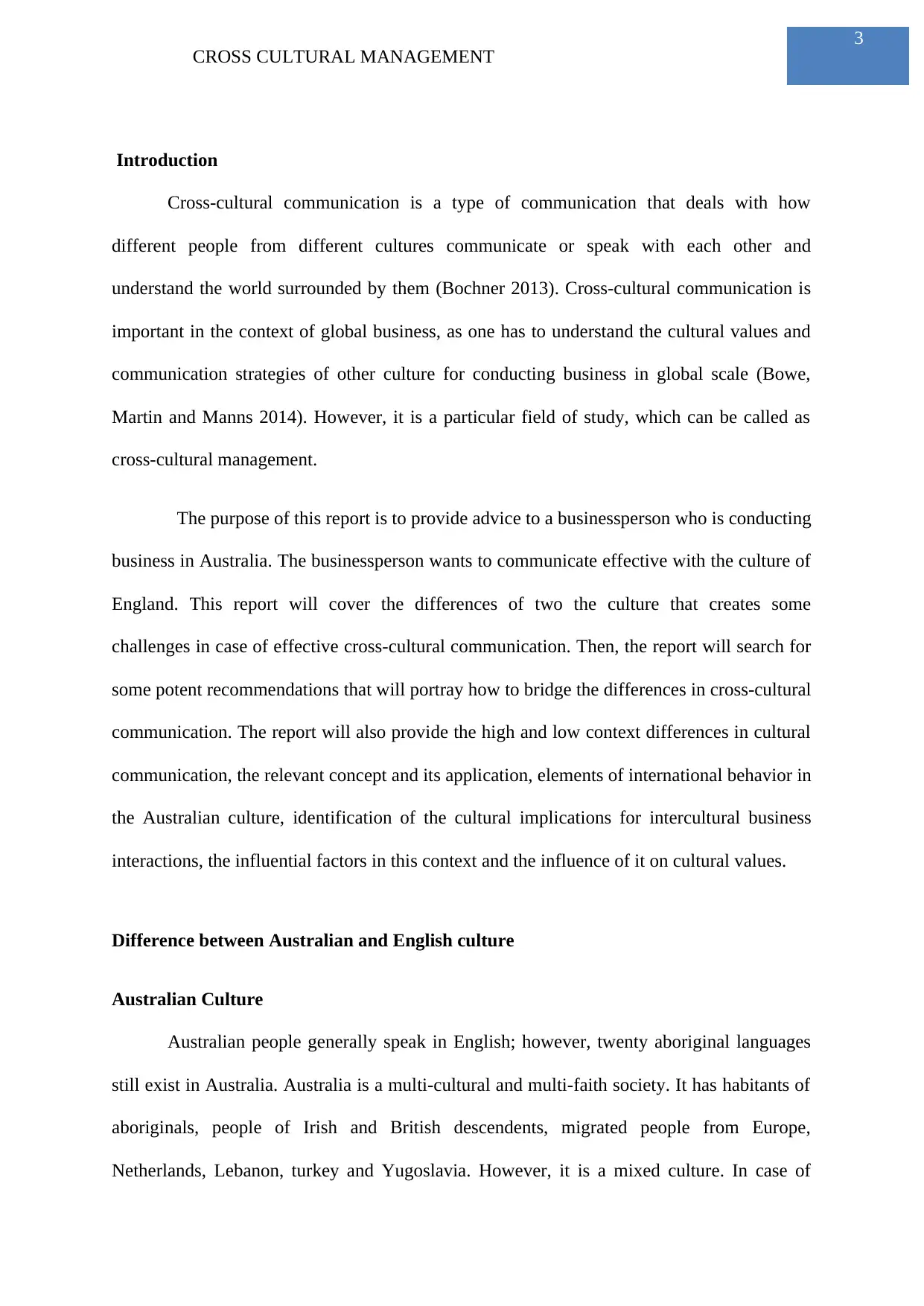
3
CROSS CULTURAL MANAGEMENT
Introduction
Cross-cultural communication is a type of communication that deals with how
different people from different cultures communicate or speak with each other and
understand the world surrounded by them (Bochner 2013). Cross-cultural communication is
important in the context of global business, as one has to understand the cultural values and
communication strategies of other culture for conducting business in global scale (Bowe,
Martin and Manns 2014). However, it is a particular field of study, which can be called as
cross-cultural management.
The purpose of this report is to provide advice to a businessperson who is conducting
business in Australia. The businessperson wants to communicate effective with the culture of
England. This report will cover the differences of two the culture that creates some
challenges in case of effective cross-cultural communication. Then, the report will search for
some potent recommendations that will portray how to bridge the differences in cross-cultural
communication. The report will also provide the high and low context differences in cultural
communication, the relevant concept and its application, elements of international behavior in
the Australian culture, identification of the cultural implications for intercultural business
interactions, the influential factors in this context and the influence of it on cultural values.
Difference between Australian and English culture
Australian Culture
Australian people generally speak in English; however, twenty aboriginal languages
still exist in Australia. Australia is a multi-cultural and multi-faith society. It has habitants of
aboriginals, people of Irish and British descendents, migrated people from Europe,
Netherlands, Lebanon, turkey and Yugoslavia. However, it is a mixed culture. In case of
CROSS CULTURAL MANAGEMENT
Introduction
Cross-cultural communication is a type of communication that deals with how
different people from different cultures communicate or speak with each other and
understand the world surrounded by them (Bochner 2013). Cross-cultural communication is
important in the context of global business, as one has to understand the cultural values and
communication strategies of other culture for conducting business in global scale (Bowe,
Martin and Manns 2014). However, it is a particular field of study, which can be called as
cross-cultural management.
The purpose of this report is to provide advice to a businessperson who is conducting
business in Australia. The businessperson wants to communicate effective with the culture of
England. This report will cover the differences of two the culture that creates some
challenges in case of effective cross-cultural communication. Then, the report will search for
some potent recommendations that will portray how to bridge the differences in cross-cultural
communication. The report will also provide the high and low context differences in cultural
communication, the relevant concept and its application, elements of international behavior in
the Australian culture, identification of the cultural implications for intercultural business
interactions, the influential factors in this context and the influence of it on cultural values.
Difference between Australian and English culture
Australian Culture
Australian people generally speak in English; however, twenty aboriginal languages
still exist in Australia. Australia is a multi-cultural and multi-faith society. It has habitants of
aboriginals, people of Irish and British descendents, migrated people from Europe,
Netherlands, Lebanon, turkey and Yugoslavia. However, it is a mixed culture. In case of
Paraphrase This Document
Need a fresh take? Get an instant paraphrase of this document with our AI Paraphraser
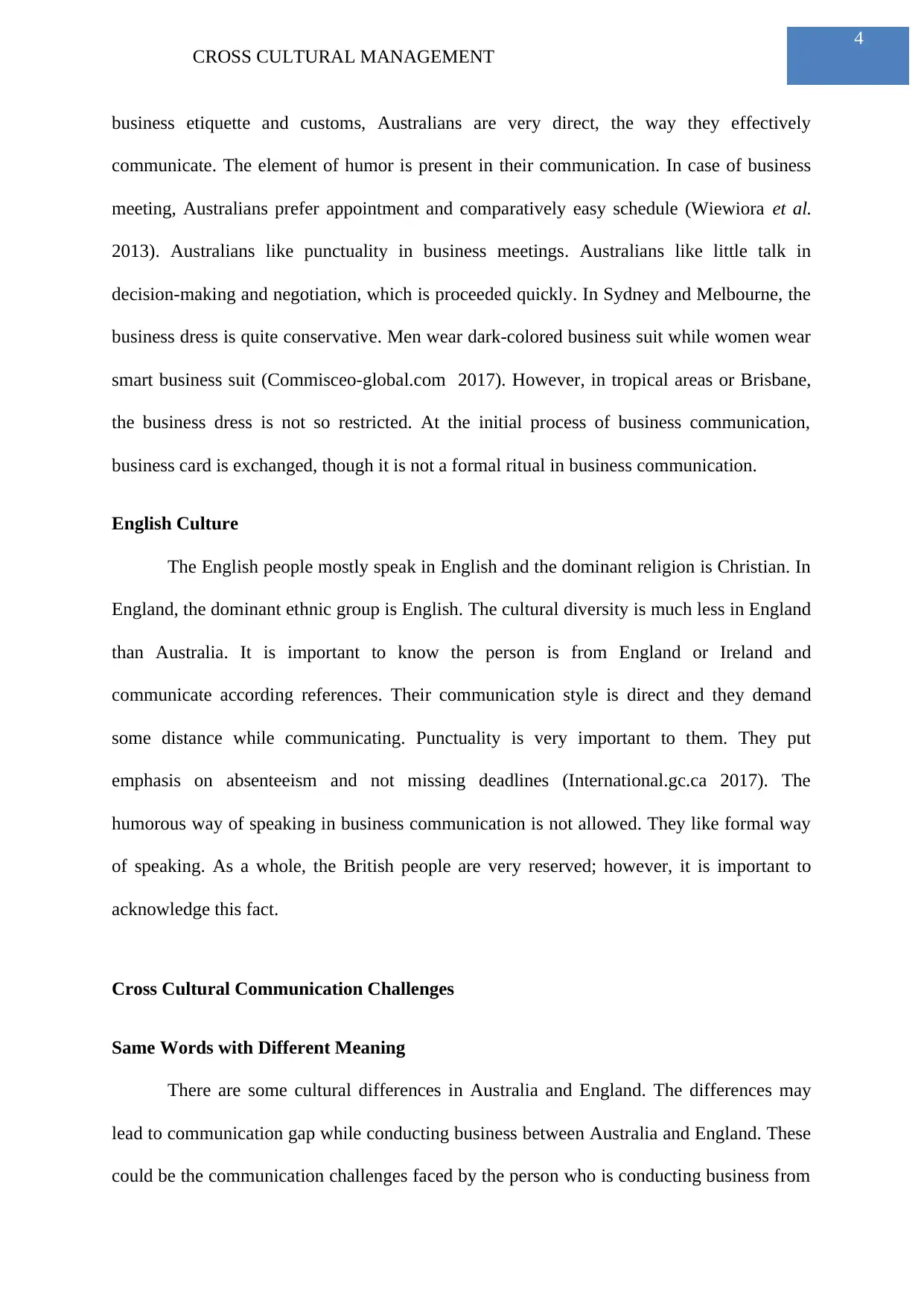
4
CROSS CULTURAL MANAGEMENT
business etiquette and customs, Australians are very direct, the way they effectively
communicate. The element of humor is present in their communication. In case of business
meeting, Australians prefer appointment and comparatively easy schedule (Wiewiora et al.
2013). Australians like punctuality in business meetings. Australians like little talk in
decision-making and negotiation, which is proceeded quickly. In Sydney and Melbourne, the
business dress is quite conservative. Men wear dark-colored business suit while women wear
smart business suit (Commisceo-global.com 2017). However, in tropical areas or Brisbane,
the business dress is not so restricted. At the initial process of business communication,
business card is exchanged, though it is not a formal ritual in business communication.
English Culture
The English people mostly speak in English and the dominant religion is Christian. In
England, the dominant ethnic group is English. The cultural diversity is much less in England
than Australia. It is important to know the person is from England or Ireland and
communicate according references. Their communication style is direct and they demand
some distance while communicating. Punctuality is very important to them. They put
emphasis on absenteeism and not missing deadlines (International.gc.ca 2017). The
humorous way of speaking in business communication is not allowed. They like formal way
of speaking. As a whole, the British people are very reserved; however, it is important to
acknowledge this fact.
Cross Cultural Communication Challenges
Same Words with Different Meaning
There are some cultural differences in Australia and England. The differences may
lead to communication gap while conducting business between Australia and England. These
could be the communication challenges faced by the person who is conducting business from
CROSS CULTURAL MANAGEMENT
business etiquette and customs, Australians are very direct, the way they effectively
communicate. The element of humor is present in their communication. In case of business
meeting, Australians prefer appointment and comparatively easy schedule (Wiewiora et al.
2013). Australians like punctuality in business meetings. Australians like little talk in
decision-making and negotiation, which is proceeded quickly. In Sydney and Melbourne, the
business dress is quite conservative. Men wear dark-colored business suit while women wear
smart business suit (Commisceo-global.com 2017). However, in tropical areas or Brisbane,
the business dress is not so restricted. At the initial process of business communication,
business card is exchanged, though it is not a formal ritual in business communication.
English Culture
The English people mostly speak in English and the dominant religion is Christian. In
England, the dominant ethnic group is English. The cultural diversity is much less in England
than Australia. It is important to know the person is from England or Ireland and
communicate according references. Their communication style is direct and they demand
some distance while communicating. Punctuality is very important to them. They put
emphasis on absenteeism and not missing deadlines (International.gc.ca 2017). The
humorous way of speaking in business communication is not allowed. They like formal way
of speaking. As a whole, the British people are very reserved; however, it is important to
acknowledge this fact.
Cross Cultural Communication Challenges
Same Words with Different Meaning
There are some cultural differences in Australia and England. The differences may
lead to communication gap while conducting business between Australia and England. These
could be the communication challenges faced by the person who is conducting business from
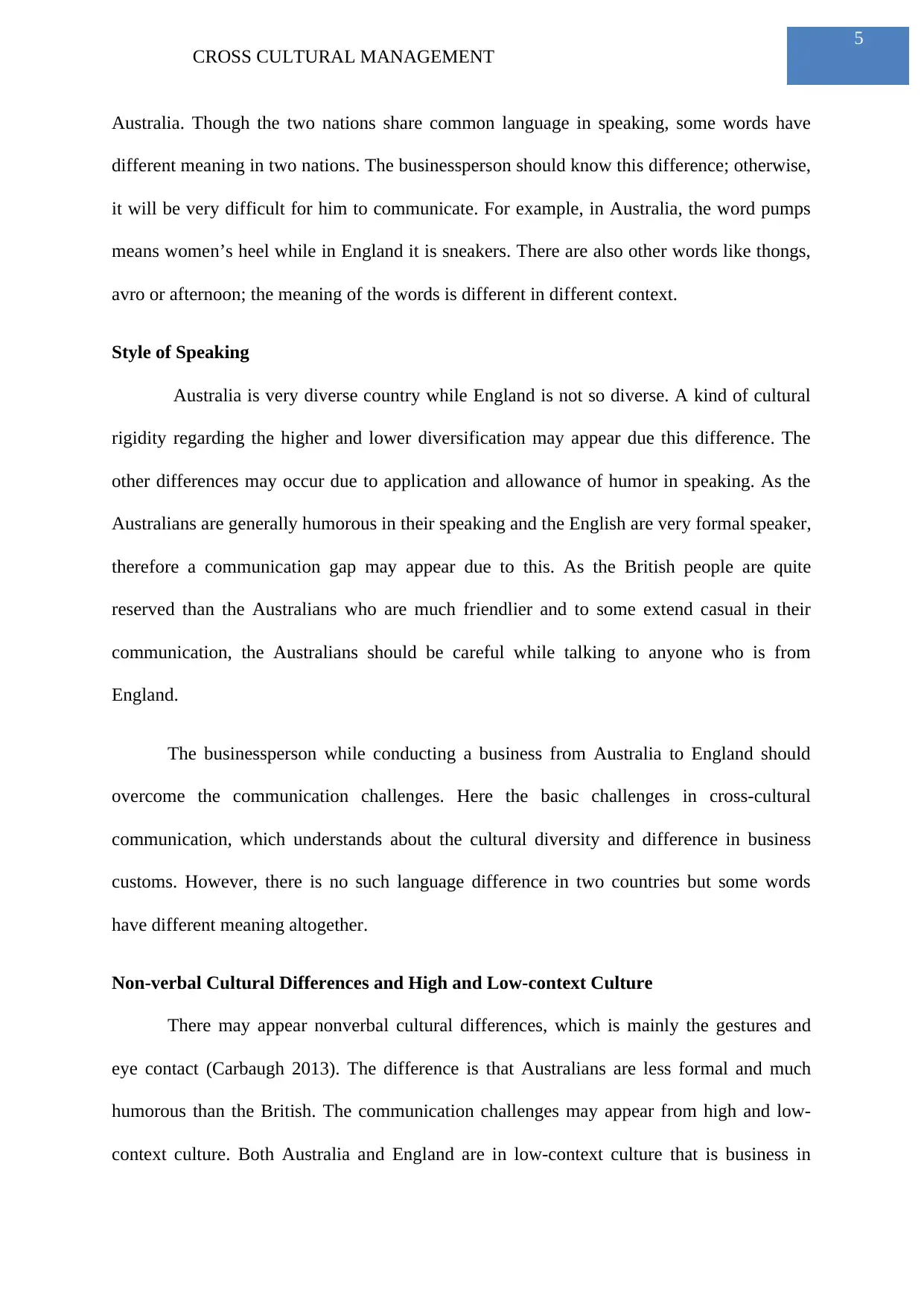
5
CROSS CULTURAL MANAGEMENT
Australia. Though the two nations share common language in speaking, some words have
different meaning in two nations. The businessperson should know this difference; otherwise,
it will be very difficult for him to communicate. For example, in Australia, the word pumps
means women’s heel while in England it is sneakers. There are also other words like thongs,
avro or afternoon; the meaning of the words is different in different context.
Style of Speaking
Australia is very diverse country while England is not so diverse. A kind of cultural
rigidity regarding the higher and lower diversification may appear due this difference. The
other differences may occur due to application and allowance of humor in speaking. As the
Australians are generally humorous in their speaking and the English are very formal speaker,
therefore a communication gap may appear due to this. As the British people are quite
reserved than the Australians who are much friendlier and to some extend casual in their
communication, the Australians should be careful while talking to anyone who is from
England.
The businessperson while conducting a business from Australia to England should
overcome the communication challenges. Here the basic challenges in cross-cultural
communication, which understands about the cultural diversity and difference in business
customs. However, there is no such language difference in two countries but some words
have different meaning altogether.
Non-verbal Cultural Differences and High and Low-context Culture
There may appear nonverbal cultural differences, which is mainly the gestures and
eye contact (Carbaugh 2013). The difference is that Australians are less formal and much
humorous than the British. The communication challenges may appear from high and low-
context culture. Both Australia and England are in low-context culture that is business in
CROSS CULTURAL MANAGEMENT
Australia. Though the two nations share common language in speaking, some words have
different meaning in two nations. The businessperson should know this difference; otherwise,
it will be very difficult for him to communicate. For example, in Australia, the word pumps
means women’s heel while in England it is sneakers. There are also other words like thongs,
avro or afternoon; the meaning of the words is different in different context.
Style of Speaking
Australia is very diverse country while England is not so diverse. A kind of cultural
rigidity regarding the higher and lower diversification may appear due this difference. The
other differences may occur due to application and allowance of humor in speaking. As the
Australians are generally humorous in their speaking and the English are very formal speaker,
therefore a communication gap may appear due to this. As the British people are quite
reserved than the Australians who are much friendlier and to some extend casual in their
communication, the Australians should be careful while talking to anyone who is from
England.
The businessperson while conducting a business from Australia to England should
overcome the communication challenges. Here the basic challenges in cross-cultural
communication, which understands about the cultural diversity and difference in business
customs. However, there is no such language difference in two countries but some words
have different meaning altogether.
Non-verbal Cultural Differences and High and Low-context Culture
There may appear nonverbal cultural differences, which is mainly the gestures and
eye contact (Carbaugh 2013). The difference is that Australians are less formal and much
humorous than the British. The communication challenges may appear from high and low-
context culture. Both Australia and England are in low-context culture that is business in
⊘ This is a preview!⊘
Do you want full access?
Subscribe today to unlock all pages.

Trusted by 1+ million students worldwide
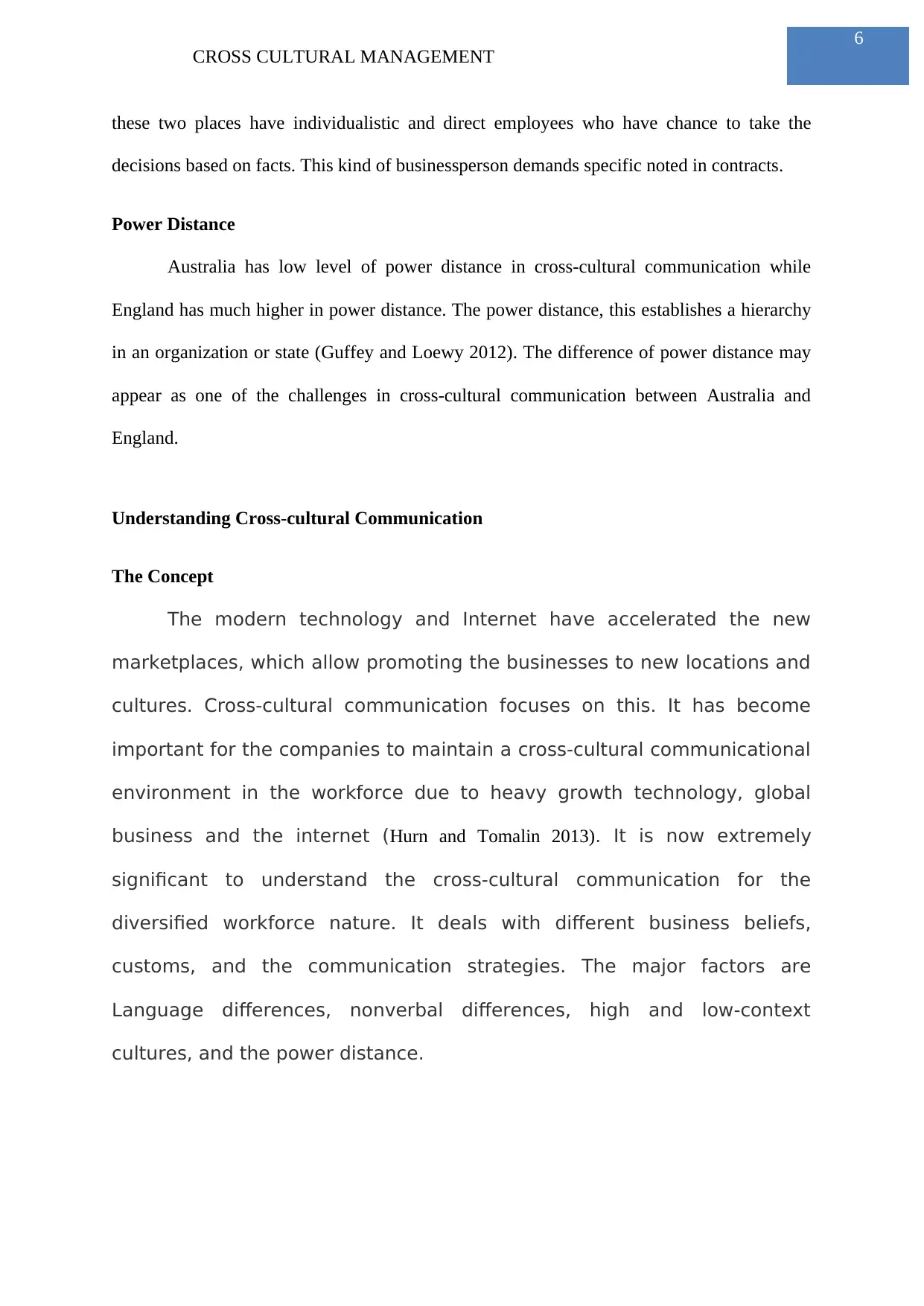
6
CROSS CULTURAL MANAGEMENT
these two places have individualistic and direct employees who have chance to take the
decisions based on facts. This kind of businessperson demands specific noted in contracts.
Power Distance
Australia has low level of power distance in cross-cultural communication while
England has much higher in power distance. The power distance, this establishes a hierarchy
in an organization or state (Guffey and Loewy 2012). The difference of power distance may
appear as one of the challenges in cross-cultural communication between Australia and
England.
Understanding Cross-cultural Communication
The Concept
The modern technology and Internet have accelerated the new
marketplaces, which allow promoting the businesses to new locations and
cultures. Cross-cultural communication focuses on this. It has become
important for the companies to maintain a cross-cultural communicational
environment in the workforce due to heavy growth technology, global
business and the internet (Hurn and Tomalin 2013). It is now extremely
significant to understand the cross-cultural communication for the
diversified workforce nature. It deals with different business beliefs,
customs, and the communication strategies. The major factors are
Language differences, nonverbal differences, high and low-context
cultures, and the power distance.
CROSS CULTURAL MANAGEMENT
these two places have individualistic and direct employees who have chance to take the
decisions based on facts. This kind of businessperson demands specific noted in contracts.
Power Distance
Australia has low level of power distance in cross-cultural communication while
England has much higher in power distance. The power distance, this establishes a hierarchy
in an organization or state (Guffey and Loewy 2012). The difference of power distance may
appear as one of the challenges in cross-cultural communication between Australia and
England.
Understanding Cross-cultural Communication
The Concept
The modern technology and Internet have accelerated the new
marketplaces, which allow promoting the businesses to new locations and
cultures. Cross-cultural communication focuses on this. It has become
important for the companies to maintain a cross-cultural communicational
environment in the workforce due to heavy growth technology, global
business and the internet (Hurn and Tomalin 2013). It is now extremely
significant to understand the cross-cultural communication for the
diversified workforce nature. It deals with different business beliefs,
customs, and the communication strategies. The major factors are
Language differences, nonverbal differences, high and low-context
cultures, and the power distance.
Paraphrase This Document
Need a fresh take? Get an instant paraphrase of this document with our AI Paraphraser
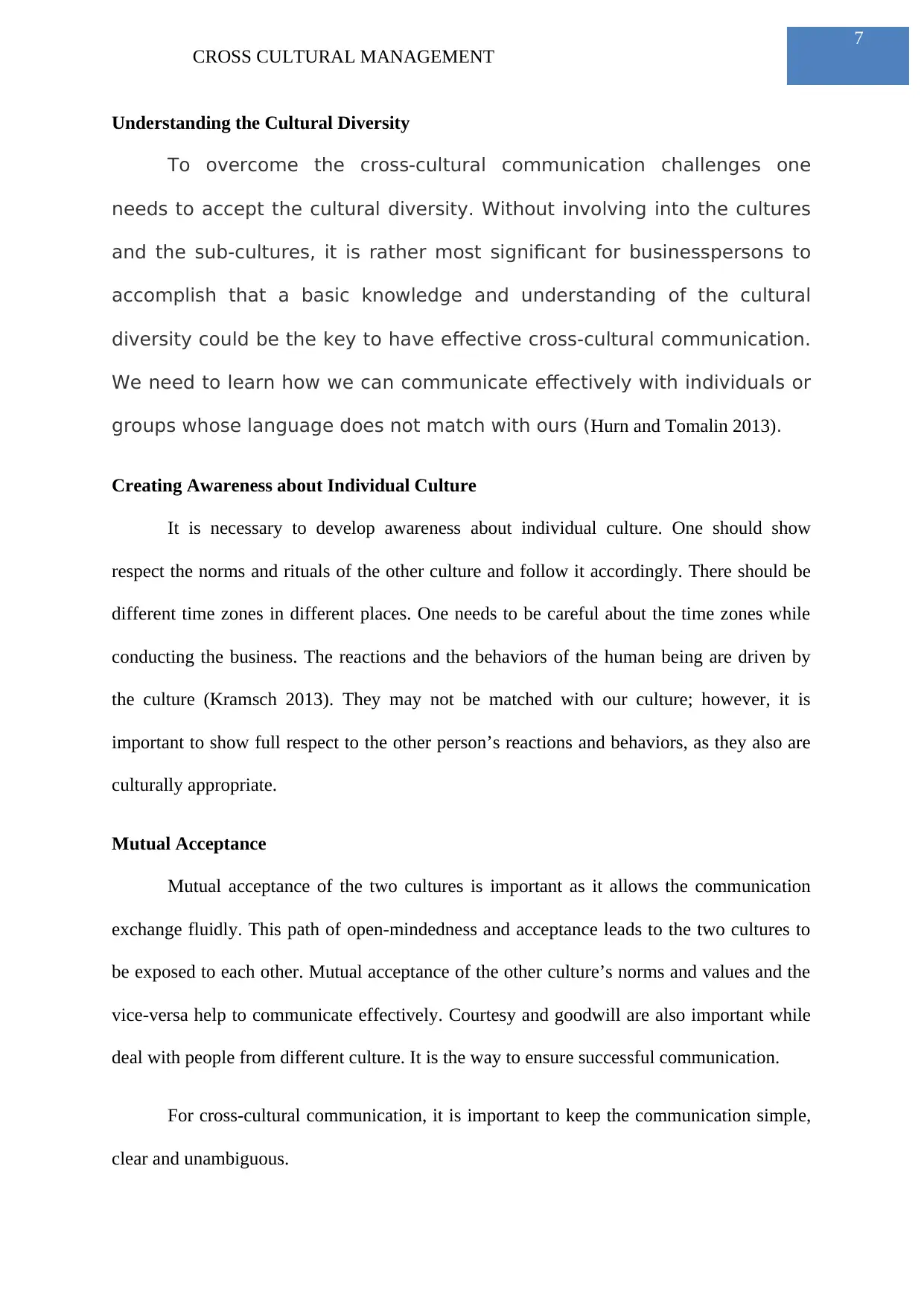
7
CROSS CULTURAL MANAGEMENT
Understanding the Cultural Diversity
To overcome the cross-cultural communication challenges one
needs to accept the cultural diversity. Without involving into the cultures
and the sub-cultures, it is rather most significant for businesspersons to
accomplish that a basic knowledge and understanding of the cultural
diversity could be the key to have effective cross-cultural communication.
We need to learn how we can communicate effectively with individuals or
groups whose language does not match with ours (Hurn and Tomalin 2013).
Creating Awareness about Individual Culture
It is necessary to develop awareness about individual culture. One should show
respect the norms and rituals of the other culture and follow it accordingly. There should be
different time zones in different places. One needs to be careful about the time zones while
conducting the business. The reactions and the behaviors of the human being are driven by
the culture (Kramsch 2013). They may not be matched with our culture; however, it is
important to show full respect to the other person’s reactions and behaviors, as they also are
culturally appropriate.
Mutual Acceptance
Mutual acceptance of the two cultures is important as it allows the communication
exchange fluidly. This path of open-mindedness and acceptance leads to the two cultures to
be exposed to each other. Mutual acceptance of the other culture’s norms and values and the
vice-versa help to communicate effectively. Courtesy and goodwill are also important while
deal with people from different culture. It is the way to ensure successful communication.
For cross-cultural communication, it is important to keep the communication simple,
clear and unambiguous.
CROSS CULTURAL MANAGEMENT
Understanding the Cultural Diversity
To overcome the cross-cultural communication challenges one
needs to accept the cultural diversity. Without involving into the cultures
and the sub-cultures, it is rather most significant for businesspersons to
accomplish that a basic knowledge and understanding of the cultural
diversity could be the key to have effective cross-cultural communication.
We need to learn how we can communicate effectively with individuals or
groups whose language does not match with ours (Hurn and Tomalin 2013).
Creating Awareness about Individual Culture
It is necessary to develop awareness about individual culture. One should show
respect the norms and rituals of the other culture and follow it accordingly. There should be
different time zones in different places. One needs to be careful about the time zones while
conducting the business. The reactions and the behaviors of the human being are driven by
the culture (Kramsch 2013). They may not be matched with our culture; however, it is
important to show full respect to the other person’s reactions and behaviors, as they also are
culturally appropriate.
Mutual Acceptance
Mutual acceptance of the two cultures is important as it allows the communication
exchange fluidly. This path of open-mindedness and acceptance leads to the two cultures to
be exposed to each other. Mutual acceptance of the other culture’s norms and values and the
vice-versa help to communicate effectively. Courtesy and goodwill are also important while
deal with people from different culture. It is the way to ensure successful communication.
For cross-cultural communication, it is important to keep the communication simple,
clear and unambiguous.
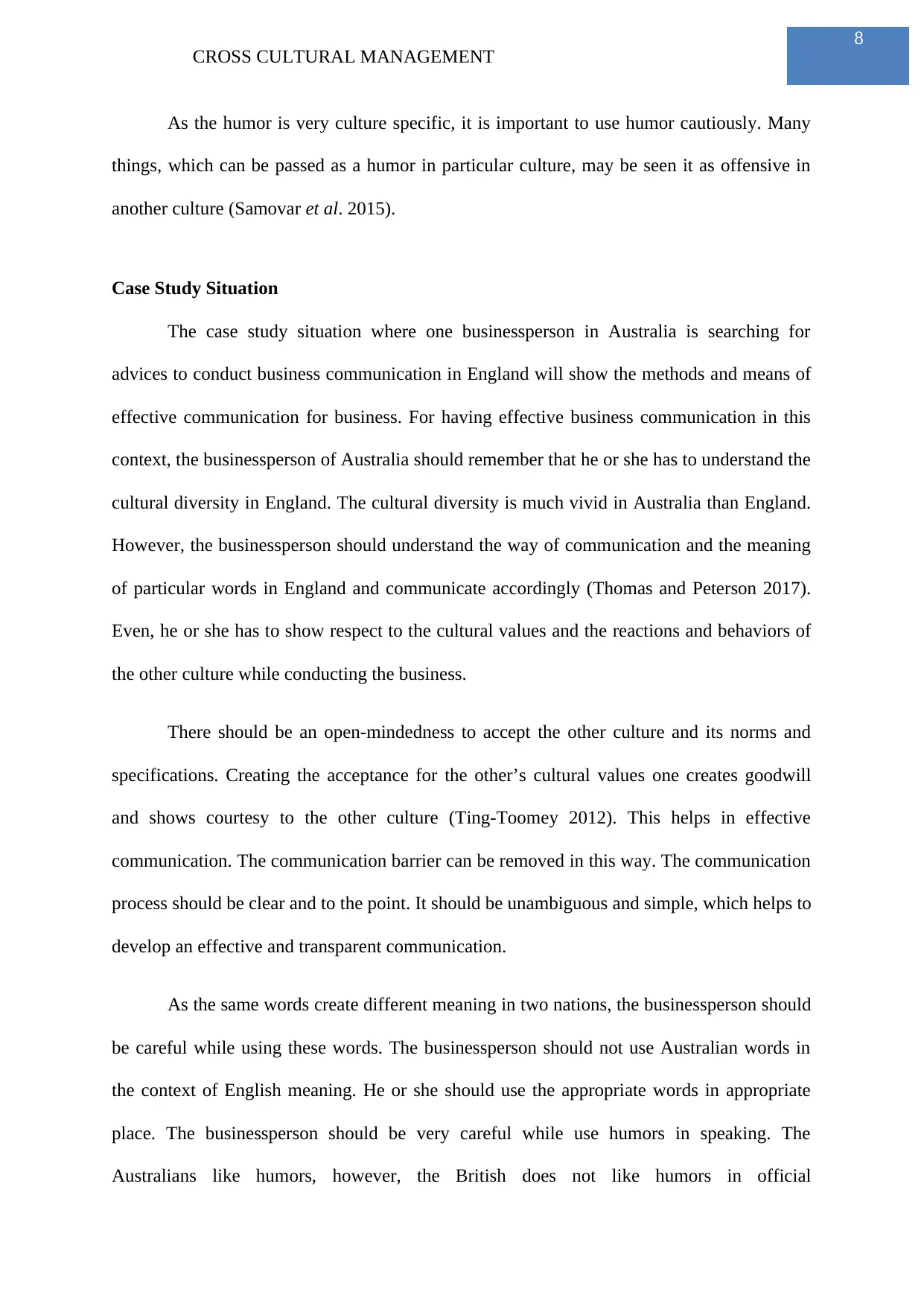
8
CROSS CULTURAL MANAGEMENT
As the humor is very culture specific, it is important to use humor cautiously. Many
things, which can be passed as a humor in particular culture, may be seen it as offensive in
another culture (Samovar et al. 2015).
Case Study Situation
The case study situation where one businessperson in Australia is searching for
advices to conduct business communication in England will show the methods and means of
effective communication for business. For having effective business communication in this
context, the businessperson of Australia should remember that he or she has to understand the
cultural diversity in England. The cultural diversity is much vivid in Australia than England.
However, the businessperson should understand the way of communication and the meaning
of particular words in England and communicate accordingly (Thomas and Peterson 2017).
Even, he or she has to show respect to the cultural values and the reactions and behaviors of
the other culture while conducting the business.
There should be an open-mindedness to accept the other culture and its norms and
specifications. Creating the acceptance for the other’s cultural values one creates goodwill
and shows courtesy to the other culture (Ting-Toomey 2012). This helps in effective
communication. The communication barrier can be removed in this way. The communication
process should be clear and to the point. It should be unambiguous and simple, which helps to
develop an effective and transparent communication.
As the same words create different meaning in two nations, the businessperson should
be careful while using these words. The businessperson should not use Australian words in
the context of English meaning. He or she should use the appropriate words in appropriate
place. The businessperson should be very careful while use humors in speaking. The
Australians like humors, however, the British does not like humors in official
CROSS CULTURAL MANAGEMENT
As the humor is very culture specific, it is important to use humor cautiously. Many
things, which can be passed as a humor in particular culture, may be seen it as offensive in
another culture (Samovar et al. 2015).
Case Study Situation
The case study situation where one businessperson in Australia is searching for
advices to conduct business communication in England will show the methods and means of
effective communication for business. For having effective business communication in this
context, the businessperson of Australia should remember that he or she has to understand the
cultural diversity in England. The cultural diversity is much vivid in Australia than England.
However, the businessperson should understand the way of communication and the meaning
of particular words in England and communicate accordingly (Thomas and Peterson 2017).
Even, he or she has to show respect to the cultural values and the reactions and behaviors of
the other culture while conducting the business.
There should be an open-mindedness to accept the other culture and its norms and
specifications. Creating the acceptance for the other’s cultural values one creates goodwill
and shows courtesy to the other culture (Ting-Toomey 2012). This helps in effective
communication. The communication barrier can be removed in this way. The communication
process should be clear and to the point. It should be unambiguous and simple, which helps to
develop an effective and transparent communication.
As the same words create different meaning in two nations, the businessperson should
be careful while using these words. The businessperson should not use Australian words in
the context of English meaning. He or she should use the appropriate words in appropriate
place. The businessperson should be very careful while use humors in speaking. The
Australians like humors, however, the British does not like humors in official
⊘ This is a preview!⊘
Do you want full access?
Subscribe today to unlock all pages.

Trusted by 1+ million students worldwide
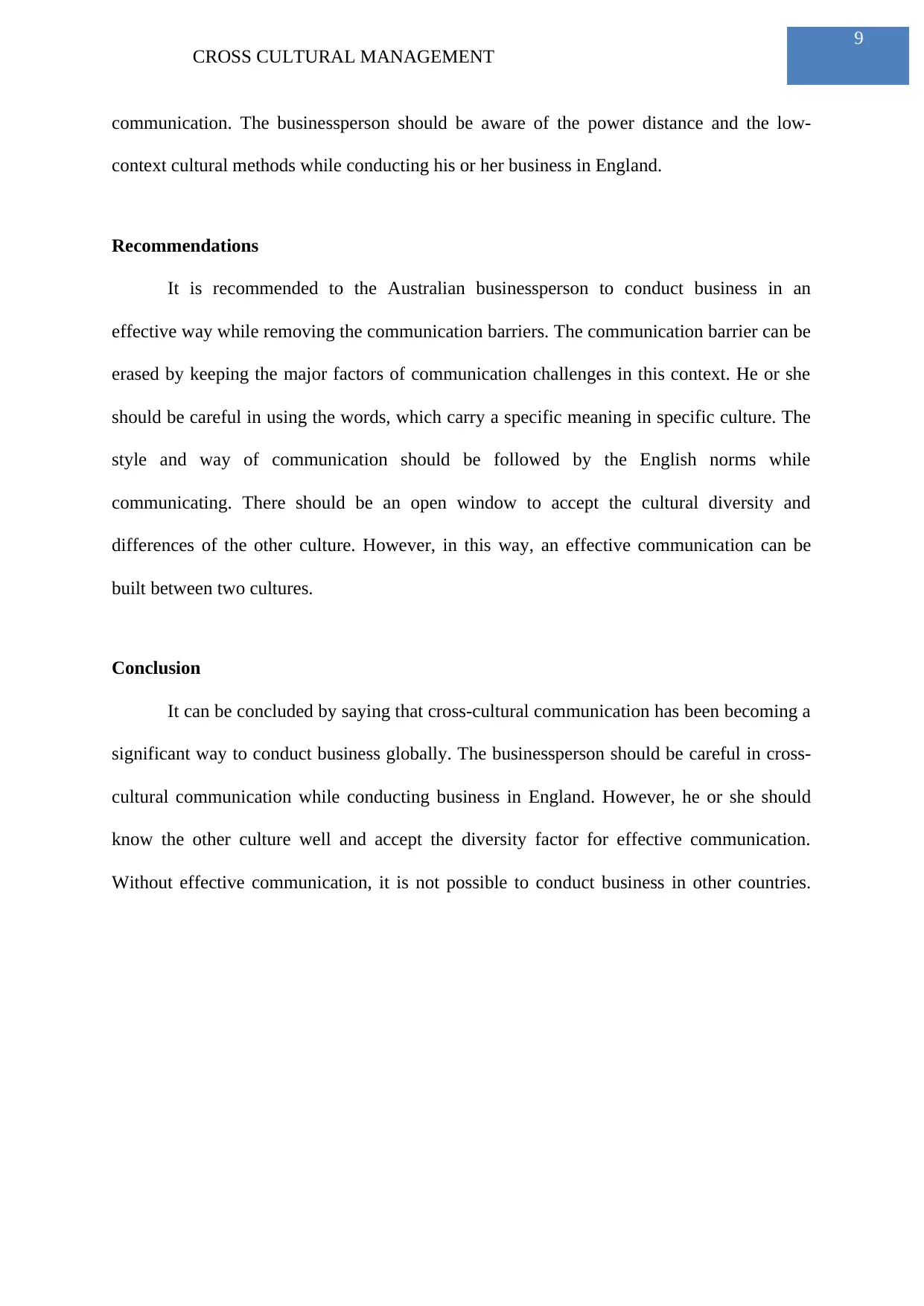
9
CROSS CULTURAL MANAGEMENT
communication. The businessperson should be aware of the power distance and the low-
context cultural methods while conducting his or her business in England.
Recommendations
It is recommended to the Australian businessperson to conduct business in an
effective way while removing the communication barriers. The communication barrier can be
erased by keeping the major factors of communication challenges in this context. He or she
should be careful in using the words, which carry a specific meaning in specific culture. The
style and way of communication should be followed by the English norms while
communicating. There should be an open window to accept the cultural diversity and
differences of the other culture. However, in this way, an effective communication can be
built between two cultures.
Conclusion
It can be concluded by saying that cross-cultural communication has been becoming a
significant way to conduct business globally. The businessperson should be careful in cross-
cultural communication while conducting business in England. However, he or she should
know the other culture well and accept the diversity factor for effective communication.
Without effective communication, it is not possible to conduct business in other countries.
CROSS CULTURAL MANAGEMENT
communication. The businessperson should be aware of the power distance and the low-
context cultural methods while conducting his or her business in England.
Recommendations
It is recommended to the Australian businessperson to conduct business in an
effective way while removing the communication barriers. The communication barrier can be
erased by keeping the major factors of communication challenges in this context. He or she
should be careful in using the words, which carry a specific meaning in specific culture. The
style and way of communication should be followed by the English norms while
communicating. There should be an open window to accept the cultural diversity and
differences of the other culture. However, in this way, an effective communication can be
built between two cultures.
Conclusion
It can be concluded by saying that cross-cultural communication has been becoming a
significant way to conduct business globally. The businessperson should be careful in cross-
cultural communication while conducting business in England. However, he or she should
know the other culture well and accept the diversity factor for effective communication.
Without effective communication, it is not possible to conduct business in other countries.
Paraphrase This Document
Need a fresh take? Get an instant paraphrase of this document with our AI Paraphraser
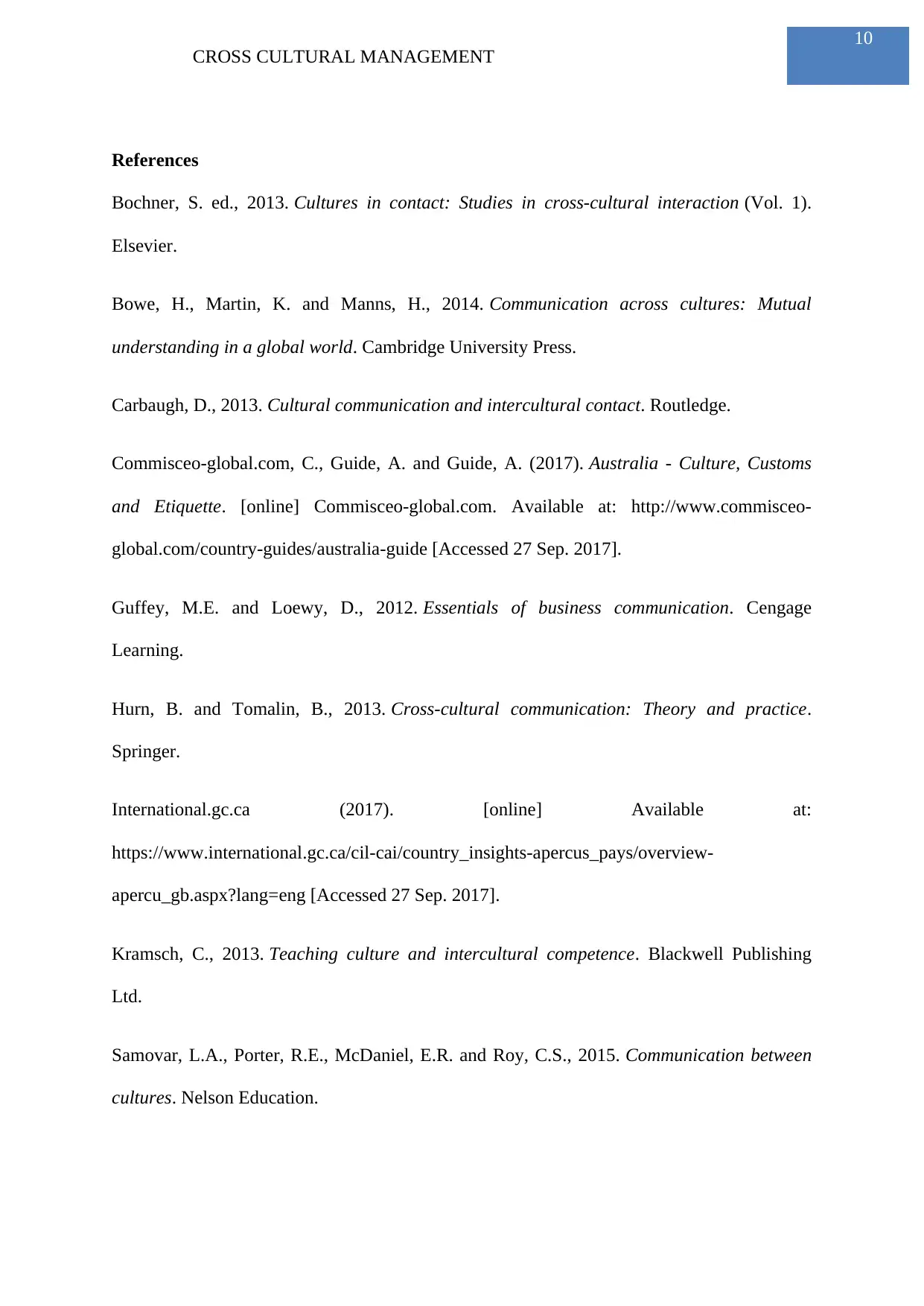
10
CROSS CULTURAL MANAGEMENT
References
Bochner, S. ed., 2013. Cultures in contact: Studies in cross-cultural interaction (Vol. 1).
Elsevier.
Bowe, H., Martin, K. and Manns, H., 2014. Communication across cultures: Mutual
understanding in a global world. Cambridge University Press.
Carbaugh, D., 2013. Cultural communication and intercultural contact. Routledge.
Commisceo-global.com, C., Guide, A. and Guide, A. (2017). Australia - Culture, Customs
and Etiquette. [online] Commisceo-global.com. Available at: http://www.commisceo-
global.com/country-guides/australia-guide [Accessed 27 Sep. 2017].
Guffey, M.E. and Loewy, D., 2012. Essentials of business communication. Cengage
Learning.
Hurn, B. and Tomalin, B., 2013. Cross-cultural communication: Theory and practice.
Springer.
International.gc.ca (2017). [online] Available at:
https://www.international.gc.ca/cil-cai/country_insights-apercus_pays/overview-
apercu_gb.aspx?lang=eng [Accessed 27 Sep. 2017].
Kramsch, C., 2013. Teaching culture and intercultural competence. Blackwell Publishing
Ltd.
Samovar, L.A., Porter, R.E., McDaniel, E.R. and Roy, C.S., 2015. Communication between
cultures. Nelson Education.
CROSS CULTURAL MANAGEMENT
References
Bochner, S. ed., 2013. Cultures in contact: Studies in cross-cultural interaction (Vol. 1).
Elsevier.
Bowe, H., Martin, K. and Manns, H., 2014. Communication across cultures: Mutual
understanding in a global world. Cambridge University Press.
Carbaugh, D., 2013. Cultural communication and intercultural contact. Routledge.
Commisceo-global.com, C., Guide, A. and Guide, A. (2017). Australia - Culture, Customs
and Etiquette. [online] Commisceo-global.com. Available at: http://www.commisceo-
global.com/country-guides/australia-guide [Accessed 27 Sep. 2017].
Guffey, M.E. and Loewy, D., 2012. Essentials of business communication. Cengage
Learning.
Hurn, B. and Tomalin, B., 2013. Cross-cultural communication: Theory and practice.
Springer.
International.gc.ca (2017). [online] Available at:
https://www.international.gc.ca/cil-cai/country_insights-apercus_pays/overview-
apercu_gb.aspx?lang=eng [Accessed 27 Sep. 2017].
Kramsch, C., 2013. Teaching culture and intercultural competence. Blackwell Publishing
Ltd.
Samovar, L.A., Porter, R.E., McDaniel, E.R. and Roy, C.S., 2015. Communication between
cultures. Nelson Education.

11
CROSS CULTURAL MANAGEMENT
Thomas, D.C. and Peterson, M.F., 2017. Cross-cultural management: Essential concepts.
Sage Publications.
Ting-Toomey, S., 2012. Communicating across cultures. Guilford Press.
Wiewiora, A., Trigunarsyah, B., Murphy, G. and Coffey, V., 2013. Organizational culture
and willingness to share knowledge: A competing values perspective in Australian
context. International Journal of Project Management, 31(8), pp.1163-1174.
CROSS CULTURAL MANAGEMENT
Thomas, D.C. and Peterson, M.F., 2017. Cross-cultural management: Essential concepts.
Sage Publications.
Ting-Toomey, S., 2012. Communicating across cultures. Guilford Press.
Wiewiora, A., Trigunarsyah, B., Murphy, G. and Coffey, V., 2013. Organizational culture
and willingness to share knowledge: A competing values perspective in Australian
context. International Journal of Project Management, 31(8), pp.1163-1174.
⊘ This is a preview!⊘
Do you want full access?
Subscribe today to unlock all pages.

Trusted by 1+ million students worldwide
1 out of 12
Related Documents
Your All-in-One AI-Powered Toolkit for Academic Success.
+13062052269
info@desklib.com
Available 24*7 on WhatsApp / Email
![[object Object]](/_next/static/media/star-bottom.7253800d.svg)
Unlock your academic potential
Copyright © 2020–2025 A2Z Services. All Rights Reserved. Developed and managed by ZUCOL.





